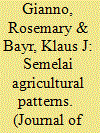|
|
|
Sort Order |
|
|
|
Items / Page
|
|
|
|
|
|
|
| Srl | Item |
| 1 |
ID:
089374


|
|
|
|
|
| Publication |
2009.
|
| Summary/Abstract |
What were the indigenous agricultural and population patterns in peninsular Malaysia's southern lowlands? What factors produced these patterns? Based on our analysis of ethnographic and historical evidence, as well as aerial photographs taken in 1948 in the Tasek Bera and Sungai Bera watersheds, the Semelai, an Orang Asli group, had a robust and productive subsistence agricultural system emphasising rice but insured by cassava. These photographs, from the P.D.R. Williams-Hunt Collection, provide an unusual record of Semelai agriculture prior to settlement in 1954 and contribute to our knowledge of indigenous economic patterns in the southern lowlands, which have received little ethnographic attention.
|
|
|
|
|
|
|
|
|
|
|
|
|
|
|
|
| 2 |
ID:
096576


|
|
|
|
|
| Publication |
2009.
|
| Summary/Abstract |
What were the indigenous agricultural and population patterns in peninsular Malaysia's southern lowlands? What factors produced these patterns? Based on our analysis of ethnographic and historical evidence, as well as aerial photographs taken in 1948 in the Tasek Bera and Sungai Bera watersheds, the Semelai, an Orang Asli group, had a robust and productive subsistence agricultural system emphasising rice but insured by cassava. These photographs, from the P.D.R. Williams-Hunt Collection, provide an unusual record of Semelai agriculture prior to settlement in 1954 and contribute to our knowledge of indigenous economic patterns in the southern lowlands, which have received little ethnographic attention.
|
|
|
|
|
|
|
|
|
|
|
|
|
|
|
|
| 3 |
ID:
191696


|
|
|
|
|
| Summary/Abstract |
This article investigates the history of the ethnonyms Temoq, Semelai, Semaq Beri and Jakun, which label Orang Asli groups in the south-central lowlands of Peninsular Malaysia. It combines ethnographic and historical accounts and census analysis to argue that each of these ethnonyms, in the twentieth century, became attached to the groups that now carry them by R.J. Wilkinson and other colonial administrator/anthropologists who were primarily concerned with finding traces of supposed primitive ancestors of modern humans, but who determined that language had to be used as a proxy toward that end. Clarifying the basis of that classification makes the system of ethnonyms that became official somewhat clearer. The article delves deepest into the genesis of ‘Temoq’, through an analysis of the ethnography of H.D. Collings and through the linguistics of the word. It argues that the Semelai word tmoʔ derives from the Malay word tembok [təmboʔ], meaning ‘tattered and dissolute in appearance’, and has been used by the Semelai to achieve social distance from the Temoq, who the Semelai also call /smaʔ bri/ ‘forest people’. It further suggests that the people now known as Temoq may themselves have once been known as ‘Semelai’.
|
|
|
|
|
|
|
|
|
|
|
|
|
|
|
|
|
|
|
|
|